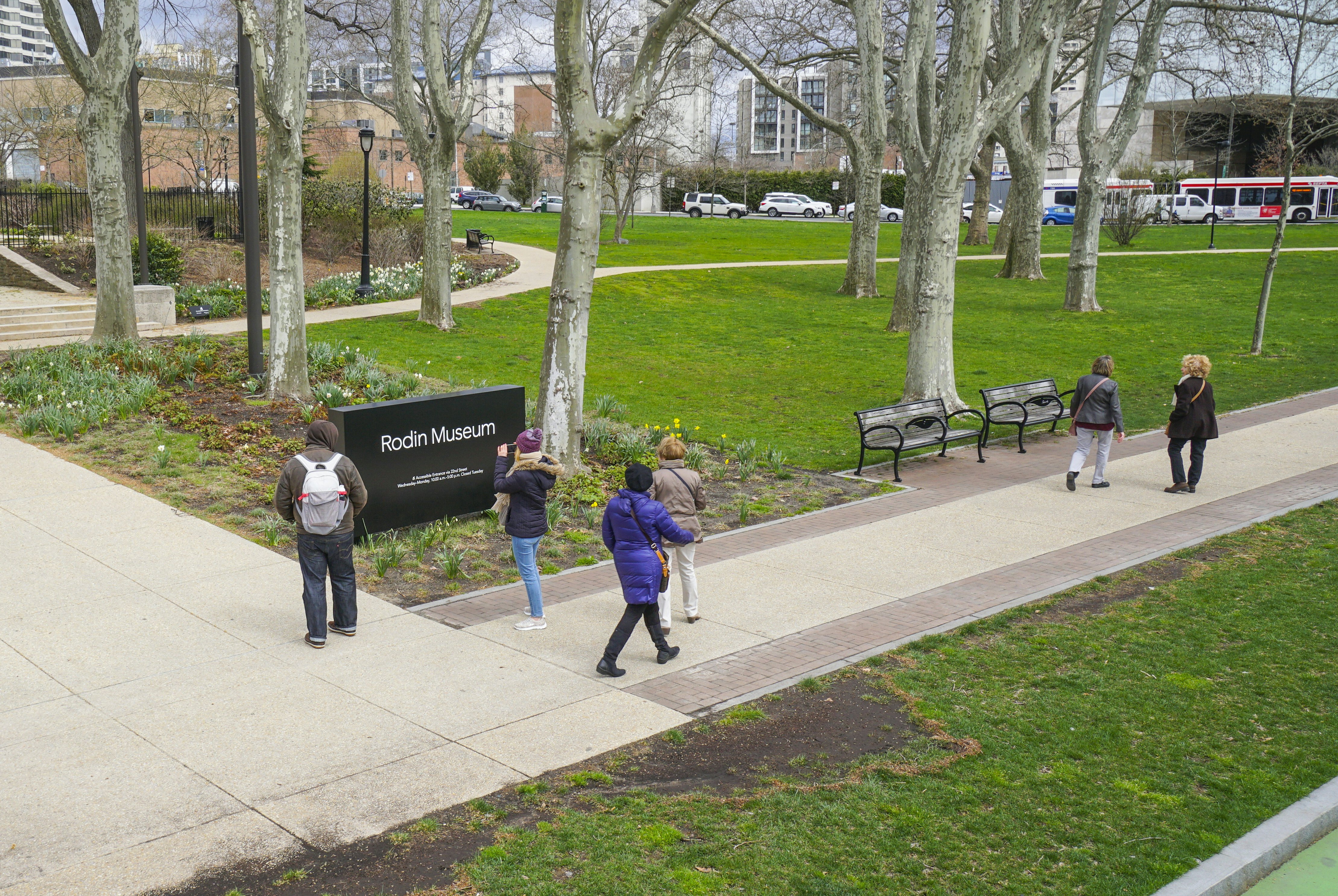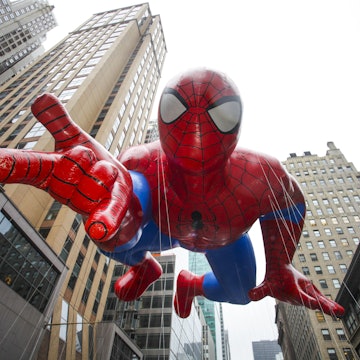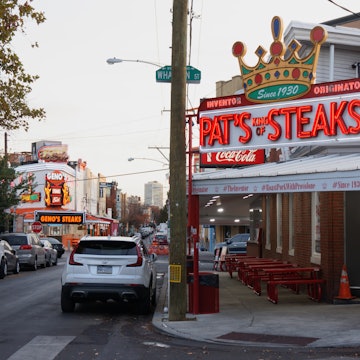

Explore Philadelphia on foot and learn more about its history for free © Zave Smith / Getty Images
One of the reasons Philadelphia is sometimes referred to as New York City’s sixth borough is the influx of former New Yorkers seeking more affordable and manageable lives in Philly.
This migration only accelerated during the pandemic. Housing costs in Philly, while rising, still compare very favorably with other East Coast metropolises, and relatively affordable living expenses translate into making this a budget-friendly destination for travelers.
A good chunk of your expenses should be earmarked for Philadelphia's excellent museums, but there are some ways of reducing those costs, and wandering the city’s beautiful historic neighborhoods won’t cost you a dime. The thriving restaurant scene caters to all budgets and there’s little need for a vehicle of your own to get around.
Fly into Philadelphia or Newark?
Only 14 miles from Center City, Philadelphia’s International Airport couldn’t be more convenient. However, the number of routes serviced has diminished and flights can involve an extra connection and may be expensive.
Flying in and out of Newark International Airport, 80 miles to the north in New Jersey, can be a more affordable option, especially for international flights. Of course, it's important to factor in the cost of onward travel to Philly (rental car, Uber, or NJ Transit) to ensure the savings are worth the effort.
Consider riding the rails instead of flying
Philly has good train connections and it's worth checking well in advance of your trip to see if there are any bargain tickets available. Amtrak and SEPTA’s New Jersey transit trains use Philadelphia’s grand, historic 30th St Station in West Philly. Several bus routes stop by the station and taxis and ride-calling apps are generally affordable.
Get around by bus or bike
You can’t beat the value of the hop-on-hop-off Philly Phlash Bus Loop from the Zoo to Reading Terminal Market to Olde City to Eastern State Penitentiary ($5 for a 1-day pass; $9 for a 2-day pass). Indego, Philadelphia’s bike-sharing program, is also great for traversing the city’s flat streets on a budget.
If you’re exploring beyond the compact city center, buy a SEPTA travel card (known as "the SEPTA key"), good for buses or the subway ($2 per ride, $2.50 without a key card). Buses are especially easy and convenient, but take the schedules with a grain of salt. The subway has only two lines and is good for traveling longer distances along its north-south and east-west axes but can be sketchy at night.

Schedule your visit to save money on museums
The city’s two major, world-class art institutions, the Barnes Foundation and the Philadelphia Museum of Art are free on the first Sunday of every month; the latter also offers pay-what-you-wish on Friday evenings.
The garden of the Rodin Museum is free and a lovely place to rest and break up a walk along Benjamin Franklin Parkway (there are a few small galleries inside that are pay-what-you-wish). The new Calder Gardens museum, dedicated to the sculptural works of Alexander Calder, is scheduled to open across the street in late 2024; check for admission prices and discounts.
If you’re planning to visit several cultural spots, consider the City Pass – it offers great savings when you visit multiple attractions, including the Franklin Institute and the zoo, both great for kids (for three attractions it’s $54 adult/$42 child; for 5 attractions it’s $82 for adult/$62 child). The Go City pass is a 3-day all-inclusive ($104 for adults and $69 for children).
Get more bang for your buck at sporting events
Unlike most pro sports stadiums, Citizens Bank Park, where the Phillies play MLB baseball, allows you to bring in your own food (snacks, sandwiches, etc.) and non-alcoholic beverages (in sealed plastic bottles). This can save you lots of money given the exorbitant prices charged at stadium food stands.
Tickets, however, especially at Eagles and Sixers games can be pricey, and playoffs outrageously so. The city’s increasingly popular pro soccer team, the Union, plays out at Subaru Park, south of the airport; tickets are generally more affordable here by comparison.
Want sports on a budget? Remember, this is a college town, home to the University of Pennsylvania, Drexel and Temple, to name just a few (several highly regarded smaller liberal arts colleges are located not far north of the city). Penn’s Palestra, once one of the country’s largest stadiums when it was built in 1927, is a great place to check out a women’s or men’s college basketball game.
On a brisk fall Saturday, football games at Penn’s Franklin Field are great. Penn students throw bread or toast onto the field, a tradition since the 1970s, though one that is increasingly controversial and viewed as wasteful given food insecurity and the ever-increasing cost of living.
On spring and fall weekends head to picturesque Boathouse Row along Kelly Drive for world-class (and free) high school and college rowing.
Timing is everything with accommodation
Avoid Taylor Swift concert dates – that’s a golden rule across the US. And, if you can, also avoid graduation and homecoming weekends and other big events, such as when World Cup soccer games are scheduled to be played here in 2026.
You can sometimes score good deals on summer weekends when everyone goes down the shore. Dorm beds in the Apple Hostel, in the Old City, will get you the cheapest overnight accommodation.

Eat well for less at markets and food trucks
Philadelphia has many restaurants worth a relative splurge but there are plenty of inexpensive options as well. Halal carts – which specialize in gyros or chicken shawarma – are found all over the city and make for excellent, economical meals. The same goes for the food trucks on Penn's Campus in West Philly.
One of South Philly’s highlights, the Italian Market is the place for quality produce and budget-minded meals. Vendors sell Italian sandwiches and pizza along 9th St. from Christian St. to Federal St. and casual Mexican eateries are concentrated south of Washington on 9th. Nearby is Little Saigon, known for its Vietnamese restaurants serving affordable banh mi and noodles; our favorites are Ba Le Bakery and Nam Phuong.
The city’s Chinatown is one of the country’s largest with a great variety of Asian fare, from soup dumplings and dim sum to ramen and Peking duck. Most are excellent value, including the all-you-can-eat hotpots if your appetite is up to the challenge.
Another can’t-miss Philly standby, the Reading Terminal Market, is also great for bargain meals. A few to highlight: Beiler's Amish Bakery for apple fritters or sticky buns; Pearl’s Oyster Bar for the best oyster stew in the city; Tommy DiNic's for meat sandwiches; and Kamal’s Middle Eastern Specialties for healthy juices.
There are plenty of inexpensive happy hours with good food all over the city. A few to look out for are Graffiti Bar in Midtown Village and Mission Taqueria in Center City West. The dive bar Tattooed Mom on South St. has food specials Monday through Thursday, daily happy hours, and free events and entertainment several nights every week.
Create your own free history tour
Standing in line to see the Liberty Bell encased in glass is a de rigeur stop for first-time visitors, and it’s free. So are Independence Hall and Congress Hall, where the Declaration of Independence and the Constitution, respectively, were signed. Amble down charming Elfreth’s Alley, the oldest continually inhabited street in the country, and then on to Carpenter’s Hall, which hosted the first Continental Congress in 1744, and the US Mint.
Other 18th-century buildings are sprinkled throughout the city center, including the neo-classical First Bank of the United States, completed in 1797 when Philly was the capital of the US and this the first federal building.
Walking around Society Hill, and to a lesser extent Queen Village, you’ll see historical site markers signaling important firsts like the Pennsylvania Hospital and the starting point for the surveying expedition of the Mason-Dixon line. City Hall, once the world’s tallest building, is amazing to behold (it’s free to enter, though tours are paid).
Learn more about key figures in Philly's past
Unsurprisingly for one of the country’s oldest cities, Philadelphia has several historically significant cemeteries. Benjamin Franklin’s grave, amongst others, can be visited in Christ Church Burial Ground in Old City, the country’s oldest.
Historic Gloria Dei (Old Swedes') Church in Queen Village is an overlooked gem. It’s the oldest standing brick building (circa 1700) in Philly and the oldest church in Pennsylvania. St Peter’s Church’s burial grounds in Society Hill also date back to colonial times.
Laurel Hill Cemetery, along the Schuylkill River, has the best examples of Victorian funerary art in the country. Gene Kelly, and notable for Phillies fans, Harry Kalas, a beloved announcer, are buried there. Kalas’s grave site is marked by two stadium seats and a large microphone. One of the oldest graves is for a soldier who served at Custer’s Last Stand.
Entrance is free and they have some interesting events that cost very little. You can park in the lot across the street from the main entrance on Ridge or drive into the cemetery and park anywhere you like. Getting there involves a beautiful drive along the river.

Take advantage of the great outdoors
Philadelphia’s public art mural program is one of the country’s most ambitious and the massive paintings are easily visible as you walk around the city. The gorgeous mosaic Tiffany “Dream Garden” in the Curtis Center in the Old City is worth a view.
For the price of a cocktail you can get stunning views of the city from the rooftop Bok Bar in South Philly; on the Delaware waterfront, try free yoga at the Race St. pier and free art exhibitions and fairs at the Cherry St. pier, a little further north. Philadelphian families head to Three Sisters Park during the summer where kids frolic in the bucolic landscaped water feature.
Explore the city on foot
There are no large swathes of green space in central Philly. Instead, the city is sprinkled with squares, like Rittenhouse Square and Washington Square most notably, pocket parks and two riverfronts, the Schuylkill River and Delaware River. Along both sides of the Schuylkill, you’ll find well-designed walking and cycling paths of Schuylkill Banks; easy to access from Schuylkill River Park in Fitler Square, one of the city’s most upscale neighborhoods.
Craving more green space? Lovely Wissahickon Valley Park, only nine miles north of City Hall, has more than 50 miles of hiking trails. The size and scale of the surrounding trees are surprising considering how close you are to the city.
Daily costs
Hostel room: $35-45
Basic room for two: $130-200
Self-catering apartment (including Airbnb): $110-180
SEPTA: $2.50 per ride ($2 with a key card)
Americano: $3.50
Cheesesteak: $12–$15
Dinner for two: $45-100
Craft beer: $8
Total Average daily cost (3 meals a day, accommodation and small budget for activities): $75-300
















